Regimental
History: 1862 (continued)
 here
was little time for rest, however, with Confederate commander Gen.
Robert E. Lee moving his victorious armies northward for an invasion of
Maryland. The 28th Massachusetts left camp at Meridian Hill on
September 7, marching with McClellan's army until arriving at Fox's
Gap a week later. There, the Irishmen were held in reserve, supporting
the 9th Corps assault at South Mountain. That night, the regiment was
put out on the picket line and suffered six casualties during sporadic
but heavy firing.
here
was little time for rest, however, with Confederate commander Gen.
Robert E. Lee moving his victorious armies northward for an invasion of
Maryland. The 28th Massachusetts left camp at Meridian Hill on
September 7, marching with McClellan's army until arriving at Fox's
Gap a week later. There, the Irishmen were held in reserve, supporting
the 9th Corps assault at South Mountain. That night, the regiment was
put out on the picket line and suffered six casualties during sporadic
but heavy firing.
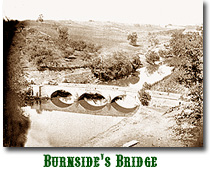 On September 17, the 28th Massachusetts
again showed its mettle during the bloody Battle of Antietam. As part
of Col. B.C. Christ's brigade of Willcox's Division, the regiment
crossed Burnside's Bridge and advanced along the north side of the
lower bridge road leading into Sharpsburg, facing hot fire from
Confederate artillery and skirmishers concealed in the area of the
Sherrick farm and on the high ground beyond. Finally, with bayonets
fixed, the 28th and the rest of Christ's brigade assualted these strong
points, driving Jones' Confederate division back through the outskirts
of town.
On September 17, the 28th Massachusetts
again showed its mettle during the bloody Battle of Antietam. As part
of Col. B.C. Christ's brigade of Willcox's Division, the regiment
crossed Burnside's Bridge and advanced along the north side of the
lower bridge road leading into Sharpsburg, facing hot fire from
Confederate artillery and skirmishers concealed in the area of the
Sherrick farm and on the high ground beyond. Finally, with bayonets
fixed, the 28th and the rest of Christ's brigade assualted these strong
points, driving Jones' Confederate division back through the outskirts
of town.
But the left flank of the 9th Corps line
soon collpased, and Willcox was ordered to withdraw his victorious
troops to avoid being outflanked. Cursing and furious at having to
relinquish ground so hard-won, the 28th Massachusetts had no choice but
to retire with the rest of the division to a defensive position along
Antietam Creek. The regiment suffered 54 casualties in the fight,
including the death of Lt. Nicholas Barrett. The battle ended with Gen.
Lee abandoning his invasion of the North and retreating back to
Virginia.
Later in the fall, while the 28th
Massachusetts was recuperating at Nolan's Ferry, Gov. Andrew appointed
a new commanding officer for the regiment. Col. Richard Byrnes, who
joined the unit on October 18, had risen through the ranks of the
pre-war Regular Army. Known as a stern disciplinarian with a rigid
attentiveness to army regulations, he had earned a reputation since the
outbreak of the war for aggressive, courageous leadership under fire as
a lieutenant in the 5th U.S. Cavalry.
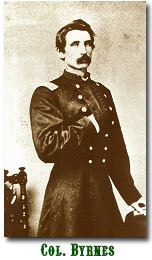 Byrnes
was not a popular choice to command the 28th Massachusetts. Most of the
regiment’s volunteer officers initially opposed the
appointment of this outsider, protesting loudly to Gov. Andrew and
threatening to resign. In the weeks that passed between the news of his
selection and his arrival to take command, seven of these officers
signed and sent to the governor a petition expressing their outrage at
Byrnes’ appointment, since it implied that none of them were
competent enough to be promoted.
Byrnes
was not a popular choice to command the 28th Massachusetts. Most of the
regiment’s volunteer officers initially opposed the
appointment of this outsider, protesting loudly to Gov. Andrew and
threatening to resign. In the weeks that passed between the news of his
selection and his arrival to take command, seven of these officers
signed and sent to the governor a petition expressing their outrage at
Byrnes’ appointment, since it implied that none of them were
competent enough to be promoted.
Gov. Andrew stood firm behind his man,
however, believing that Byrnes' experience and character were needed,
both to end the squabbling among officers and to restore discipline to
the rank and file. In time, even if he never endeared himself to the
soldiers in the ranks, Byrnes was proven to be a wise choice. He was an
excellent combat officer, noted for his coolness and bravery under fire.
It is clear that Byrnes believed he had a
mandate to fix a broken outfit. When he arrived, the few officers who
were not attached to other units, on furlough, or absent without leave
openly defied his authority. They were ignoring routine regimental
paperwork, neglecting daily guard mounts and drill, and allowing
discipline problems to run rampant.
Byrnes acted decisively and without
tolerance toward any man who did not appear to do his duty. He
immediately ordered men on detached service back to the regiment.
Byrnes relieved the Sgt. Major of duty, appointed a new one, reduced
the Quartermaster Sgt. and a number of other non-commissioned officers
to the ranks for glaring inefficiency, and ordered all NCOs to wear
chevrons, which many of them had refused to do. He ordered new drums
since the regiment had none and imposed new standards of conduct in
strict accord with army regulations. Byrnes insisted that each company
drill for an hour in the morning, ordered all companies to drill
together for an hour in the afternoon, and required a daily dress
parade with full inspection.
Although an Irish immigrant himself, Byrnes
wanted to keep his regiment up to fighting strength as well as retain
his commission as colonel. So, in the months ahead, he insisted that
recruiting encompass any and all potential volunteers, not just those
of Irish birth or heritage. This might also have been an acknowledgment
that Irish enthusiasm for the war was waning. Henceforth, a significant
and growing proportion of the rank and file were non-Irish, many even
coming from outside of Massachusetts. Even so, the unit retained its
essentially Irish character and continued to
attract ethnic Irish
recruits until the end of the
war.
 There was another significant change at
this time. Nearly a year after being formed, the 28th Massachusetts was
finally transferred to Brig. Gen. Thomas F. Meagher's famed Irish
Brigade on November 23, 1862. The new "Fourth Irish Regiment" of the
Second Brigade, First Division, 2nd Corps joined three under strength
Irish-American units that had already won an enviable record in the
army – the 63rd, 69th, and 88th New York – along
with the 116th Pennsylvania, which had been added to the brigade just a
month earlier. At the same time, the 29th Massachusetts was reassigned
to the 9th Corps, much to that unit’s satisfaction.
There was another significant change at
this time. Nearly a year after being formed, the 28th Massachusetts was
finally transferred to Brig. Gen. Thomas F. Meagher's famed Irish
Brigade on November 23, 1862. The new "Fourth Irish Regiment" of the
Second Brigade, First Division, 2nd Corps joined three under strength
Irish-American units that had already won an enviable record in the
army – the 63rd, 69th, and 88th New York – along
with the 116th Pennsylvania, which had been added to the brigade just a
month earlier. At the same time, the 29th Massachusetts was reassigned
to the 9th Corps, much to that unit’s satisfaction.
As harsh winter weather began to set in, the
men of the 28th Massachusetts found that their shelter tents provided
only meager comfort and soon began working to build ten large
50’ x 14’ log houses, one for each company. Before
they could get too comfortable in these much improved winter quarters,
however, the regiment was called upon to join its new brigade in the
Fredericksburg campaign.
The Union army's new commander, Maj. Gen.
Ambrose Burnside, was determined to push Confederate forces back toward
Richmond. Burnside initially hoped to surprise the rebels at
Fredericksburg, but due to poor planning and numerous delays, the
federals became bogged down at the Rapahannock River crossing. This
gave Gen. Robert E. Lee an opportunity to concentrate and entrench his
inferior numbers on Marye's Heights above the town. Still determined to
press the assault, Burnside elected to throw his entire force against
the Confederates, anyway.
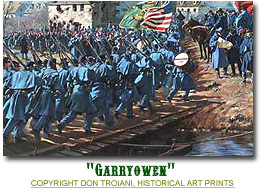 The
Irish Brigade crossed the river on December 12 and spent a cold night
in the town of Fredericksburg. On the next morning, Gen. Meagher
ordered the men of his Irish Brigade to place sprigs of green boxwood
in their forage caps to distinguish them from all other units. This was
important to him because the three New York units had recently sent
their tattered green regimental flags back to New York City for
replacement and the 116th Pennsylvania did not carry a distinctive
Irish banner.
The
Irish Brigade crossed the river on December 12 and spent a cold night
in the town of Fredericksburg. On the next morning, Gen. Meagher
ordered the men of his Irish Brigade to place sprigs of green boxwood
in their forage caps to distinguish them from all other units. This was
important to him because the three New York units had recently sent
their tattered green regimental flags back to New York City for
replacement and the 116th Pennsylvania did not carry a distinctive
Irish banner.
Meagher then positioned the Massachusetts
men in the center of the brigade line, both because they were by far
the most numerous and because they possessed the sole green Irish flag
in the brigade. In the tense hours that followed, they watched the
first line of Union soldiers go up the hill ahead of them, suffering
heavy casualties. Then, they too advanced toward the Confederate
position under a murderous fire of grape shot, canister, and bullets,
suffering horrendous casualties all along the way.
The slaughter was so great that the Irish
Brigade’s advance was actually impeded by the large number of
bodies piled on one another. Even so, the Irish managed to capture some
of the outer Confederate picket posts along a fence line about 50 yards
from the main rebel position along the sunken road. But any attempts to
move beyond this position were beaten back by the close-range rifle
fire.
A Confederate officer noted afterward that
the brave men of the Irish Brigade "pushed on beyond all former
charges, and fought and left their dead between five and twenty paces
of the sunken road."
Still determined to give a good fight, the
survivors then took cover in a slight depression behind the two-foot
high fence and blazed away at the enemy. Orders arrived instructing
them to fall back, but many either elected to stay on the firing line
until they were out of ammunition or perhaps realized that the way back
down the hill was even more perilous than staying where they were. At
this time, some of the 28th Massachusetts men sidled over to an
abandoned brick house and delivered a hot fire into the rebel line.
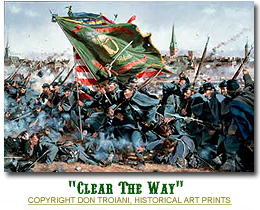 Bravely
leading the attack, the 28th Massachusetts lost 158 (38 percent) of the
416 men it sent up the bloody slope; the highest number of casualties
it would suffer in a single engagement during the entire war. Among
those who lost their lives were Lts. Edwin Weller, William Holland and
John Sullivan. The toll was heavy among all five regiments of the Irish
Brigade, which suffered 535 total casualties, two-thirds of its
strength, in the doomed assault.
Bravely
leading the attack, the 28th Massachusetts lost 158 (38 percent) of the
416 men it sent up the bloody slope; the highest number of casualties
it would suffer in a single engagement during the entire war. Among
those who lost their lives were Lts. Edwin Weller, William Holland and
John Sullivan. The toll was heavy among all five regiments of the Irish
Brigade, which suffered 535 total casualties, two-thirds of its
strength, in the doomed assault.
At dusk, the survivors of the regiment still
at the fence joined the rest of their Irish Brigade comrades in falling
back to the relative safety of the town of Fredericksburg. Col. Byrnes
stood by the colors, seeking to piece together the shattered fragments
of his regiment, which he feared had been totally annihilated. When
Gen. Edwin Sumner, commander of the 2nd Corps, rode up and rebuked a
man of the 28th Massachusetts for not being in company formation with
his comrades, the soldier replied: "This is all my company, sir."
The men of the 28th remained on the edge of
town, at the base of the hill, that night and the following day,
suffering from the severe cold, unable to reach fallen comrades due to
hostile fire from rebel pickets, and waiting for a Confederate
counterattack that never came. Finally, on the night of December 15,
the regiment crossed back over the river and by morning was back at its
old camp in Falmouth.
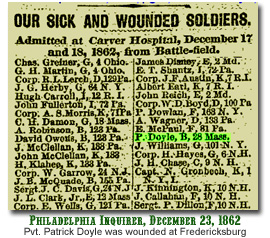 Over the coming winter, Byrnes would
continue trying to instill the regiment with discipline and restore its
sagging morale. Worthy enlisted men were quickly promoted to replace
the many sergeants and corporals lost during the battle. At the same
time, a number of non-commissioned officers were reduced to the ranks
for incompetence and neglect of duty. Officers who had absented
themselves on sick leave for extended periods were ordered to return to
duty or resign, and several of them opted for the latter.
Over the coming winter, Byrnes would
continue trying to instill the regiment with discipline and restore its
sagging morale. Worthy enlisted men were quickly promoted to replace
the many sergeants and corporals lost during the battle. At the same
time, a number of non-commissioned officers were reduced to the ranks
for incompetence and neglect of duty. Officers who had absented
themselves on sick leave for extended periods were ordered to return to
duty or resign, and several of them opted for the latter.
While Byrnes was unsuccessful in gaining any
more recruits, he did manage to procure much-needed supplies,
especially clothing and shoes, for his men who had fought and marched
almost continuously over the previous eight months.
Continued
>


